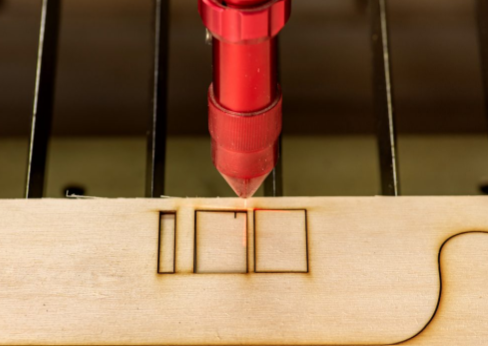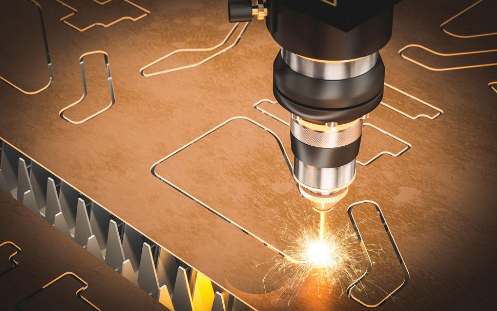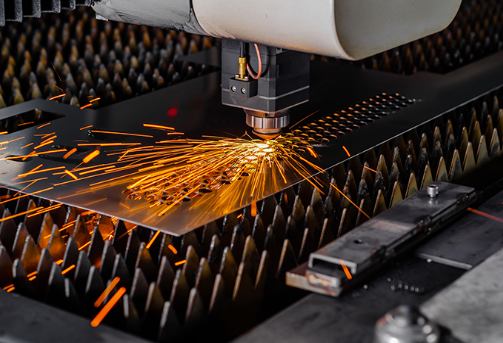Laser cutting process
Cutting through materials with a laser is an efficient production technique. Laser cutters can cut through several materials, making them exceedingly versatile and producing exact and accurate cuts.
Whether you're a professional in the field or simply curious about laser cutting's capabilities, this FAQ guide will answer common questions, provide insights into its applications, and highlight the benefits and considerations of using CNC laser cutting technology.
Can Laser Cutters Cut Through Anything?
Laser cutters are versatile tools renowned for their ability to precisely cut through a diverse array of materials with efficiency and accuracy. Common materials suitable for laser cutting are metals such as steel and aluminum, various plastics, wood, acrylic, leather, textiles, and paper. This broad compatibility makes laser beam cutting applicable across numerous industries, from manufacturing and automotive to fashion and crafts.
However, laser cutters' capability to cut through materials depends significantly on their type and thickness. While laser cutters excel at handling thin—to medium-thick materials, thicker materials may require more powerful lasers or alternative cutting methods to achieve clean cuts and maintain efficiency.
Specific materials present unique challenges for laser cutting. For instance, reflective metals can reflect the laser beam, reducing cutting effectiveness, while some plastics may emit hazardous fumes when exposed to high temperatures. Addressing these challenges often involves employing specialized techniques or coatings to optimize cutting results and ensure safety.
Which Material Should You Never Cut in the Laser Cutter?
These are some of the materials that should never be cut with the use of a laser:
ABS
In contrast to volatile materials, ABS (acrylonitrile butadiene styrene) tends to melt and burn when cut with a laser, melting and fusing the cut edges. Many toxic substances, such as phenol, phenyl cyclohexane, methyl styrene, cyanide, and derivatives of benzene, are present in the products of ABS thermal/oxidative degradation. Since ABS cannot be completely removed by char or volatility, there is a significant risk of local heating and igniting, which makes ABS a fire hazard as well.
Epoxy
Laser cutting and engraving are particularly inappropriate uses for epoxy resins, also known as polyepoxides. The gas byproducts are highly poisonous, and the quality of the results is generally regarded as poor. Detailed research on "typical" epoxies in thermal degradation lists "H2, CH4, C3H6, C2H6, CO, C2H4, and C3H8, ethane, ethylene, propylene, and propane" rather than HCN, despite the fact that hydrogen cyanide is usually mentioned as a result.
HCN cannot be ruled out as a byproduct, though, because epoxies are a broad family that differs in terms of catalysts and specifics of pre-polymer manufacturing.
It's important to note that, despite their chemical dissimilarity, polyester resins are occasionally mislabeled as epoxies. Polyesters respond better to laser cutting even though they are much more difficult to work with; therefore, a complete understanding of the materials you desire to cut is essential to achieving a good result.
Polypropylene
Laser cutting is typically considered unsuitable for polypropylene. Cutting tends to cause polypropylene to melt and fuse, which causes leftovers to overheat and smoke. Apart from being a slight nuisance, smoke isn't thought to be very dangerous. This is typically taken care of by a filtered extraction system. Effective air assistance can improve cut quality and reduce smoking.
PVC (Poly Vinyl Chloride)
When PVC is dissolved in moisture, its thermal breakdown releases hydrogen chloride and chlorine gas. Although these dangerous and extremely poisonous byproducts can theoretically be eliminated through extraction and high-quality filtration, this material is not suitable for laser cutting due to the negative effects on equipment and risk to workers.
Fiberglass
Fibreglass is regarded as a no-cut material for benchtop equipment. Very few, if any, compact machines can effectively cut the glass fiber component. The (often used) resins are said to "release toxic gases." The majority of fiberglass, also known as glass-reinforced polyester or GRP, is made with polyester resins that are more frequently thought of as cuttable rather than epoxy.
However, because polyester resins are a diverse family, it might be difficult to distinguish between different types of fiberglass material. It's wise to avoid cutting fiberglass composites on tiny, poorly ventilated machines.
How Effective is Laser Cutting?

Laser cutting process
Laser cutting is highly effective due to its high accuracy, making it ideal for applications that demand complex designs and tight tolerances. The focused laser beam allows for cutting complex shapes with minimal material waste, a significant advantage over traditional cutting methods. This precision is crucial in industries like manufacturing, where exact measurements and intricate patterns are often required for components and products.
Furthermore, laser cutting demonstrates remarkable versatility in handling a wide range of materials. It can efficiently cut metals such as laser cutting steel and aluminum, various plastics, wood, acrylic, leather, textiles, and paper. This versatility makes laser cutting suitable for diverse applications across industries, from aerospace to automotive to fashion, signage, and architectural modelling.
In terms of efficiency, laser cutting is known for its speed and ability to automate processes. The non-contact nature of laser cutting means there is less wear on cutting tools compared to traditional methods, resulting in reduced maintenance and longer machine lifespan. This efficiency not only speeds up production but also helps to save cost by minimizing material waste.
Moreover, laser cutting is environmentally advantageous due to its precision and minimal material waste. It produces cleaner cuts with less scrap, reducing overall environmental impact compared to other cutting techniques. Combined with lower energy consumption per unit of material processed, laser cutting stands out as a sustainable choice in modern manufacturing and sheet metal fabrication practices.
What Are the Negatives of Laser Cutting?

Laser cutting process
While laser cutting offers numerous benefits, there are also some drawbacks and considerations to keep in mind:
- Initial Cost: The upfront investment in a laser cutting machine can be significant, particularly for high-powered models or those equipped with advanced features. This cost can be a barrier for smaller businesses or individuals looking to adopt the technology.
- Material Limitations: Although laser cutters can handle a wide range of materials, there are limitations. Certain materials, such as highly reflective metals (e.g., copper, brass) or materials with high thermal conductivity, may require specialized equipment or techniques for effective cutting.
- Thickness Constraints: While laser cutters excel at cutting thin to medium-thickness materials, their effectiveness diminishes with thicker materials. Multiple passes or alternative cutting methods for thicker substrates can necessitate impacting efficiency and production time.
- Maintenance Requirements: Laser cutting machines require regular maintenance to ensure optimal performance. This includes cleaning lenses, checking alignment, and replacing consumables like laser tubes and focusing lenses, which adds to operational costs and downtime.
- Safety Concerns: Laser cutting involves the use of high-powered lasers, which can pose safety risks if not properly managed. Operators must adhere to safety protocols, including ensuring proper ventilation to reduce risks and wearing appropriate protective gear.
What will a laser not Cut?
Laser cutting, despite its versatility, has limitations when it comes to certain materials due to their properties and the nature of the laser itself. Here are the types of materials that lasers typically cannot effectively cut:
- Highly Reflective Metals: Metals such as copper, brass, and aluminum with highly reflective surfaces can reflect the laser beam rather than absorb it. This reflection reduces cutting efficiency and can damage the laser optics. Specialized fiber lasers or alternative cutting methods are often required for these materials.
- Transparent Materials: Materials like glass and some plastics are transparent to the laser wavelength used in standard laser-cutting machines. Since the laser beam passes through these materials without significant absorption, it cannot effectively cut them.
- Certain Ceramics and Brittle Materials: Brittle materials such as ceramic, certain types of glass, and some composites may crack or shatter under the intense heat generated by laser cutting. These materials are better suited to alternative cutting methods like waterjet cutting or specialized laser engraving techniques.
- Thick or Dense Materials: Laser cutting is less effective on materials that are very thick or exceptionally dense. The depth of penetration and the ability to maintain cutting quality diminish as material thickness increases beyond the capabilities of the laser cutter.
- Materials Releasing Hazardous Gases: Materials like PVC (Polyvinyl Chloride) and other plastics that emit hazardous gases when heated should never be cut with a laser cutter due to safety concerns related to fume emissions.
- Highly Conductive Materials: Some highly conductive materials, such as pure copper, are challenging to cut with standard CO2 lasers due to their thermal conductivity properties. Again, specialized equipment like fiber lasers may be necessary for effective cutting.
How Deep Can Laser Cutting Go?

Laser cutting material
The depth to which a laser can cut into a material depends on several factors, including the type of material, the power and type of laser used, and the desired cutting speed. In general, laser cutting is most effective for materials where the laser beam can cleanly penetrate and melt or vaporize the material in a controlled manner.
For metals, laser cutting can achieve depths typically ranging from a fraction of a millimeter to millimeters, depending on the thickness of the material and the laser's power. For example, CO2 lasers are commonly used for cutting metals and can achieve effective cutting depths up to several millimeters, depending on the specific metal and its properties.
Non-metallic materials such as plastics, wood, acrylic, and textiles can often be cut to greater depths than metals due to their different thermal properties and the laser's ability to melt or vaporize the material efficiently. The depth of cut in these materials can range from fractions of a millimeter to centimeters, depending on the material's density, composition, and the laser's power output.
Conclusion
Laser cutting offers top notch advantages in terms of precision, speed, and versatility, allowing for complex designs and efficient material processing. However, it's important to note the considerations and limitations, such as material compatibility, initial costs, and safety concerns related to certain materials. By understanding these aspects, businesses can leverage laser cutting effectively to innovate and streamline production processes while ensuring safety and quality.
